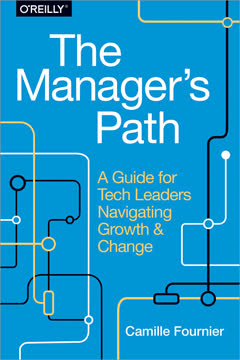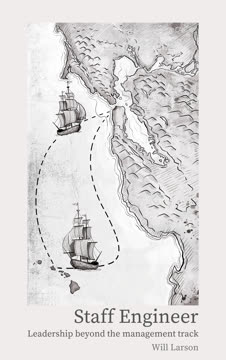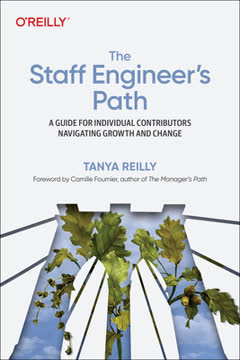Key Takeaways
1. Staff engineering is about big-picture thinking, execution, and leveling up others
Your big-picture perspective includes understanding what's possible and having good judgment.
Big-picture thinking involves stepping back to see beyond immediate details and understanding the broader context. This means considering long-term implications, initiating year-long projects, and predicting future needs. Staff engineers need to see how different teams and projects interconnect, and make decisions that benefit the entire organization rather than just one team.
Execution at the staff level involves tackling messier, more ambiguous projects that require more people and political capital. These projects often need culture change to succeed. Staff engineers must navigate complex organizational dynamics and influence without direct authority.
Leveling up others is a crucial responsibility of staff engineers. This includes intentional influence through teaching and mentoring, as well as accidental influence by being a role model. Staff engineers should raise the standards and skills of engineers within their orbit, whether it's their local team, organization, or the entire industry.
2. Understand your role, scope, and organization to maximize impact
You can't do everything, so you'll need to choose your battles.
Clarify your role by writing out your understanding of your job and sharing it with your manager. This helps align expectations and uncover any misunderstandings. Consider factors such as:
- Your reporting chain and where you sit in the organization
- Your scope of responsibility and influence
- Your work preferences and current primary focus
Map your organization to gain perspective and navigate effectively:
- Locator map: Understand where you fit in the broader company context
- Topographical map: Identify organizational terrain, including communication paths, decision-making processes, and potential obstacles
- Treasure map: Clarify long-term goals and milestones
Build relationships across the organization to increase your effectiveness. Connect with peers in other groups, understand different perspectives, and learn about challenges and priorities beyond your immediate team.
3. Create a technical vision or strategy to align and guide the organization
A strategy is a plan of action. It's how you intend to achieve your goals, navigating past the obstacles you'll meet along the way.
Develop a technical vision to describe a desired future state once objectives are achieved and major problems are solved. This creates a shared reality and empowers teams to make decisions aligned with the overall direction. A vision can range from a company-wide perspective to a single team's work.
Craft a technical strategy to outline specific plans for achieving goals and overcoming challenges. A good strategy includes:
- Diagnosis of the current situation
- Guiding policy for approaching obstacles
- Coherent actions to implement the policy
Align and communicate the vision or strategy effectively:
- Get sponsorship from leadership to ensure organizational support
- Involve key stakeholders in the creation process
- Use clear, memorable language to make it easy for others to understand and repeat
- Regularly revisit and update the document as circumstances change
4. Choose projects wisely based on impact and personal resources
By choosing to do one thing, you're implicitly choosing not to do another.
Evaluate project impact by considering:
- Alignment with company goals and priorities
- Potential to solve significant problems or create value
- Long-term implications for the organization
Assess personal resources before committing to projects:
- Time: Consider your current workload and available capacity
- Energy: Recognize which types of work energize or drain you
- Quality of life: Choose projects that align with your values and interests
- Credibility: Look for opportunities to demonstrate technical and leadership skills
- Social capital: Build goodwill by helping others and delivering on commitments
- Skills: Seek projects that allow you to learn and grow in desired areas
Balance trade-offs when selecting projects:
- Short-term vs. long-term impact
- Personal growth vs. organizational needs
- Technical depth vs. breadth of influence
Be willing to say no to projects that don't align with priorities or stretch your resources too thin.
5. Lead big projects by setting up for success and navigating obstacles
Competence means having well-founded confidence that you'll be able to solve the problem.
Set up for success by:
- Clarifying goals, constraints, and success metrics
- Defining roles and responsibilities for all involved parties
- Establishing communication channels and decision-making processes
- Creating a project structure with clear milestones and deliverables
Navigate obstacles by:
- Anticipating potential roadblocks and planning mitigation strategies
- Building relationships with key stakeholders to facilitate smoother collaboration
- Staying flexible and adapting to changing circumstances
- Communicating transparently about progress and challenges
Drive the project forward by:
- Regularly reassessing priorities and adjusting course as needed
- Making decisions and unblocking team members
- Facilitating effective meetings and information sharing
- Celebrating milestones and recognizing team contributions
6. Recognize when projects are stuck and take action to move forward
Pushing on with a doomed project is just postponing the inevitable and it prevents you from doing something more useful.
Identify common reasons projects stall:
- Blocked by dependencies on other teams or individuals
- Lack of clear direction or decision-making
- Misaligned priorities or resource constraints
- Technical challenges or unforeseen complexities
Take action to unblock projects:
- Communicate clearly to understand the root cause of the blockage
- Escalate issues to appropriate leadership when necessary
- Look for creative solutions or alternative approaches
- Consider reducing scope or adjusting timelines
- Be willing to cancel or pivot projects that are no longer viable
Learn from setbacks:
- Conduct retrospectives to identify lessons learned
- Document findings to inform future projects
- Use failures as opportunities for growth and improvement
7. Be a competent, responsible role model who remembers the bigger picture
Your words and actions carry more weight now. Be deliberate.
Demonstrate competence by:
- Continuously building knowledge and skills in your domain
- Admitting what you know and don't know
- Maintaining high standards in your work
- Being reliable and following through on commitments
Act responsibly by:
- Taking ownership of problems and their solutions
- Stepping up in emergencies and difficult situations
- Creating a calm, productive environment for your team
- Making decisions and accepting accountability for outcomes
Remember the bigger picture by:
- Considering business context and user needs in technical decisions
- Balancing short-term gains with long-term sustainability
- Anticipating future challenges and planning accordingly
- Optimizing for maintainability and ease of decommissioning
8. Use your influence to level up individuals, groups, and catalyze change
Understand that you have a perspective, that your context is not the universal context, and that your opinions and knowledge are specific to you.
Advise individuals through:
- Mentoring relationships
- Thoughtful code and design reviews
- Constructive feedback and peer evaluations
Teach and coach to build skills:
- Pair programming and shadowing
- Creating learning paths and documentation
- Developing classes and workshops
Provide guardrails to ensure safety and quality:
- Establishing best practices and coding standards
- Implementing code review processes
- Creating change management procedures
Create opportunities for growth:
- Delegating challenging tasks
- Sponsoring colleagues for high-visibility projects
- Recognizing and amplifying others' contributions
Scale your influence to groups by:
- Giving tech talks and writing articles
- Creating documentation and FAQs
- Establishing mentorship programs
Catalyze organizational change through:
- Implementing processes and automation
- Advocating for cultural shifts
- Building frameworks that outlast your direct involvement
Last updated:
FAQ
What's The Staff Engineer's Path about?
- Focus on Staff Engineers: The book is a guide for individual contributors, particularly those at the staff engineer level, focusing on their growth and responsibilities without direct reports.
- Three Pillars: It outlines three key pillars of staff engineering: big-picture thinking, execution of projects, and leveling up others.
- Navigating Ambiguity: Offers practical advice and frameworks to help engineers understand their impact and influence within their organizations.
Why should I read The Staff Engineer's Path?
- Career Development: Provides clarity on the staff engineer path, offering insights into thriving in a technical leadership role.
- Practical Guidance: Filled with actionable advice, mental models, and firsthand experiences to navigate complex organizational dynamics.
- Support for Individual Contributors: Highlights the value of technical leadership for those who prefer to remain technical contributors rather than transitioning into management.
What are the key takeaways of The Staff Engineer's Path?
- Understanding Your Role: Emphasizes the importance of understanding the expectations and responsibilities of a staff engineer.
- Building Influence: Provides strategies for influencing without authority, focusing on strong communication and leadership skills.
- Continuous Growth: Encourages personal growth and skill development to remain relevant and effective in their roles.
How does The Staff Engineer's Path define a staff engineer's role?
- Leadership Without Management: A staff engineer is a leader who influences and guides others without having direct reports.
- Autonomy and Responsibility: Requires a high degree of autonomy, identifying important work and driving initiatives that align with business objectives.
- Navigating Ambiguity: Encourages embracing ambiguity and developing the skills necessary to thrive in such an environment.
What are the three pillars of staff engineering mentioned in The Staff Engineer's Path?
- Big-Picture Thinking: Involves understanding the broader context of work and aligning efforts with organizational goals.
- Execution: Focuses on leading complex projects, navigating ambiguity, and ensuring successful delivery.
- Leveling Up Others: Emphasizes mentoring and elevating the skills of peers, fostering a culture of continuous improvement.
What specific methods or advice does The Staff Engineer's Path offer?
- Radiating Intent: Involves signaling actions and decisions to others to foster transparency and collaboration.
- Guardrails for Projects: Discusses establishing guardrails, like code and design reviews, to help colleagues work safely and effectively.
- Mentorship and Sponsorship: Emphasizes the value of mentorship and sponsorship in helping others grow.
What strategies does The Staff Engineer's Path suggest for influencing without authority?
- Build Relationships: Establishing strong relationships across teams is crucial for gaining trust and influence.
- Communicate Clearly: Articulate vision and rationale behind decisions to align others with goals.
- Leverage Credibility: Building and maintaining credibility through successful project execution and technical expertise.
How does The Staff Engineer's Path address the challenges of project management?
- Navigating Obstacles: Provides strategies for navigating common project obstacles, such as blocked dependencies.
- Clear Communication: Stresses the importance of clear communication among team members to ensure alignment.
- Iterative Improvement: Encourages an iterative approach to project management, continuously assessing and improving processes.
What role does mentorship play in The Staff Engineer's Path?
- Guiding Growth: Mentorship is a vital tool for guiding the growth of less experienced engineers.
- Knowledge Sharing: Emphasizes sharing knowledge and experiences to foster a culture of learning.
- Building Future Leaders: Mentoring others contributes to building a pipeline of future leaders in the industry.
How can I apply the concepts from The Staff Engineer's Path in my daily work?
- Set Clear Goals: Use the frameworks provided to set clear, actionable goals for projects and career development.
- Engage in Mentorship: Actively seek mentorship opportunities to enhance skills and support others.
- Communicate Effectively: Practice effective communication techniques, such as radiating intent, to improve collaboration.
What are the best quotes from The Staff Engineer's Path and what do they mean?
- "You are responsible for your career and choices.": Emphasizes taking ownership of one's career path and making deliberate choices.
- "The metric for success is whether other people want to work with you.": Highlights the significance of interpersonal skills and collaboration.
- "Software has a massive influence on the lives and livelihoods of just about everyone on earth.": Reminds engineers of their responsibility in creating reliable and ethical software.
What are the common pitfalls to avoid as described in The Staff Engineer's Path?
- Avoiding Ambiguity: Warns against vague communication, encouraging clarity and specificity.
- Neglecting Relationships: Highlights the danger of neglecting interpersonal relationships, which can hinder collaboration.
- Overengineering Solutions: Cautions against overengineering, advocating for simplicity and practicality in design and implementation.
Review Summary
The Staff Engineer's Path receives overwhelmingly positive reviews, praised for its comprehensive guidance on navigating senior technical roles. Readers appreciate its practical advice, logical organization, and emphasis on leadership beyond management. Many find it valuable for both aspiring and current staff engineers, as well as managers. The book is commended for its clear explanations, useful frameworks, and abundant references. Some readers note its verbosity but still recommend it as an essential resource for career growth in software engineering.
Similar Books










Download PDF
Download EPUB
.epub digital book format is ideal for reading ebooks on phones, tablets, and e-readers.




